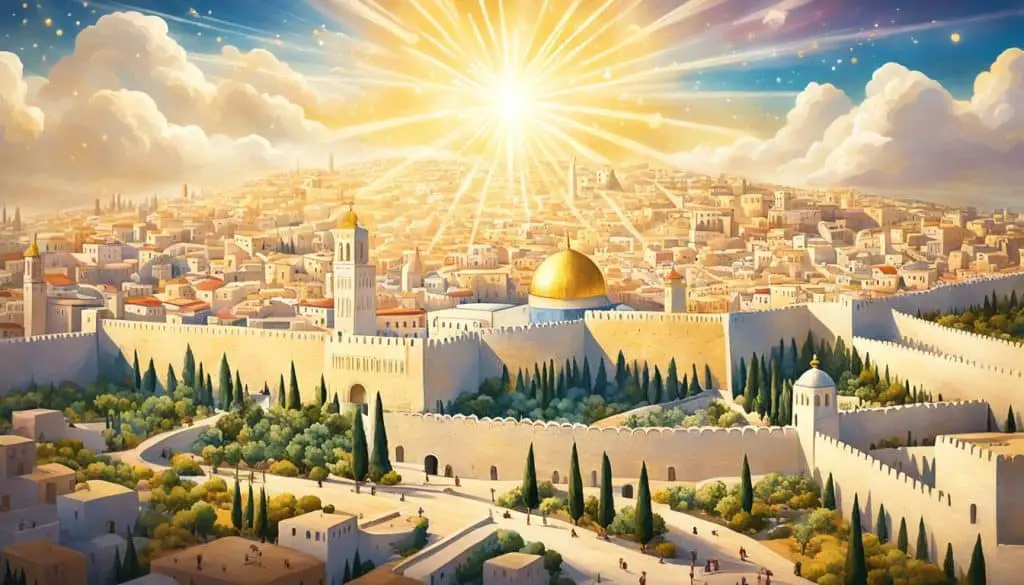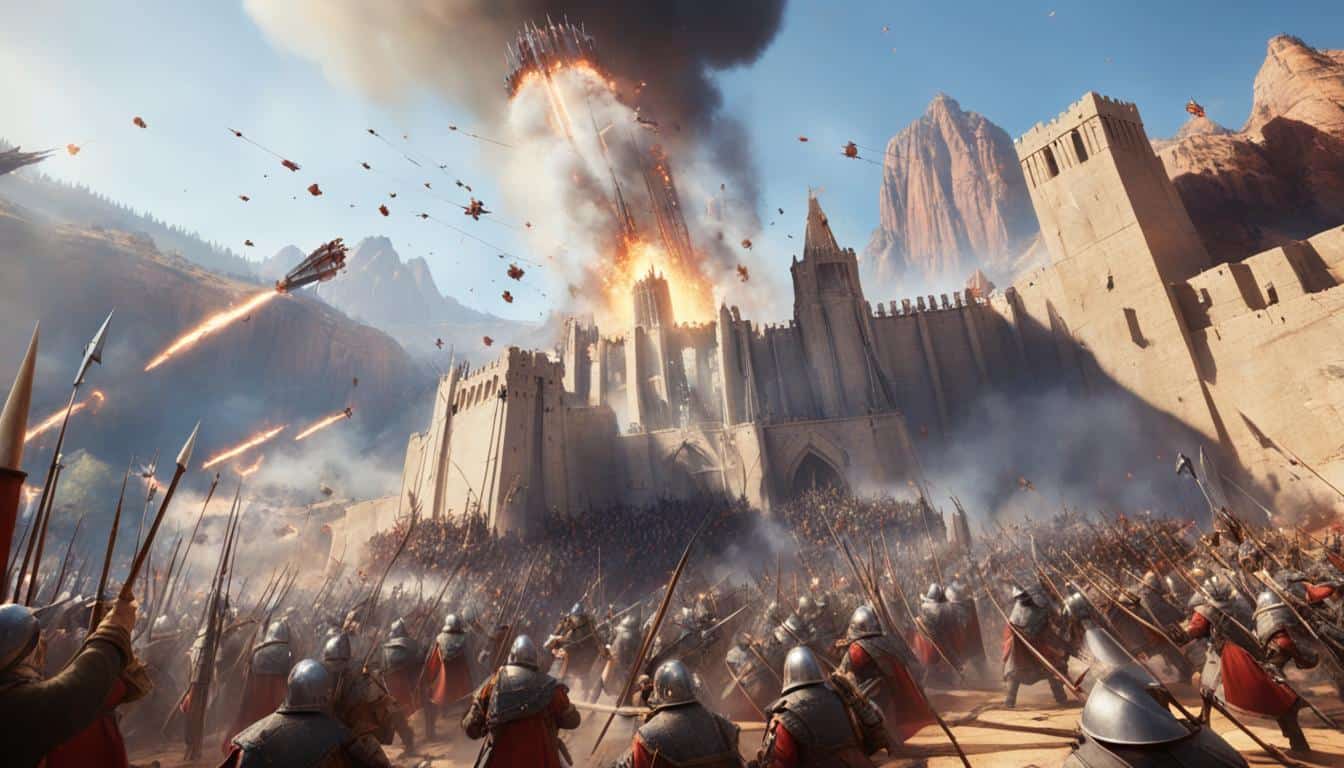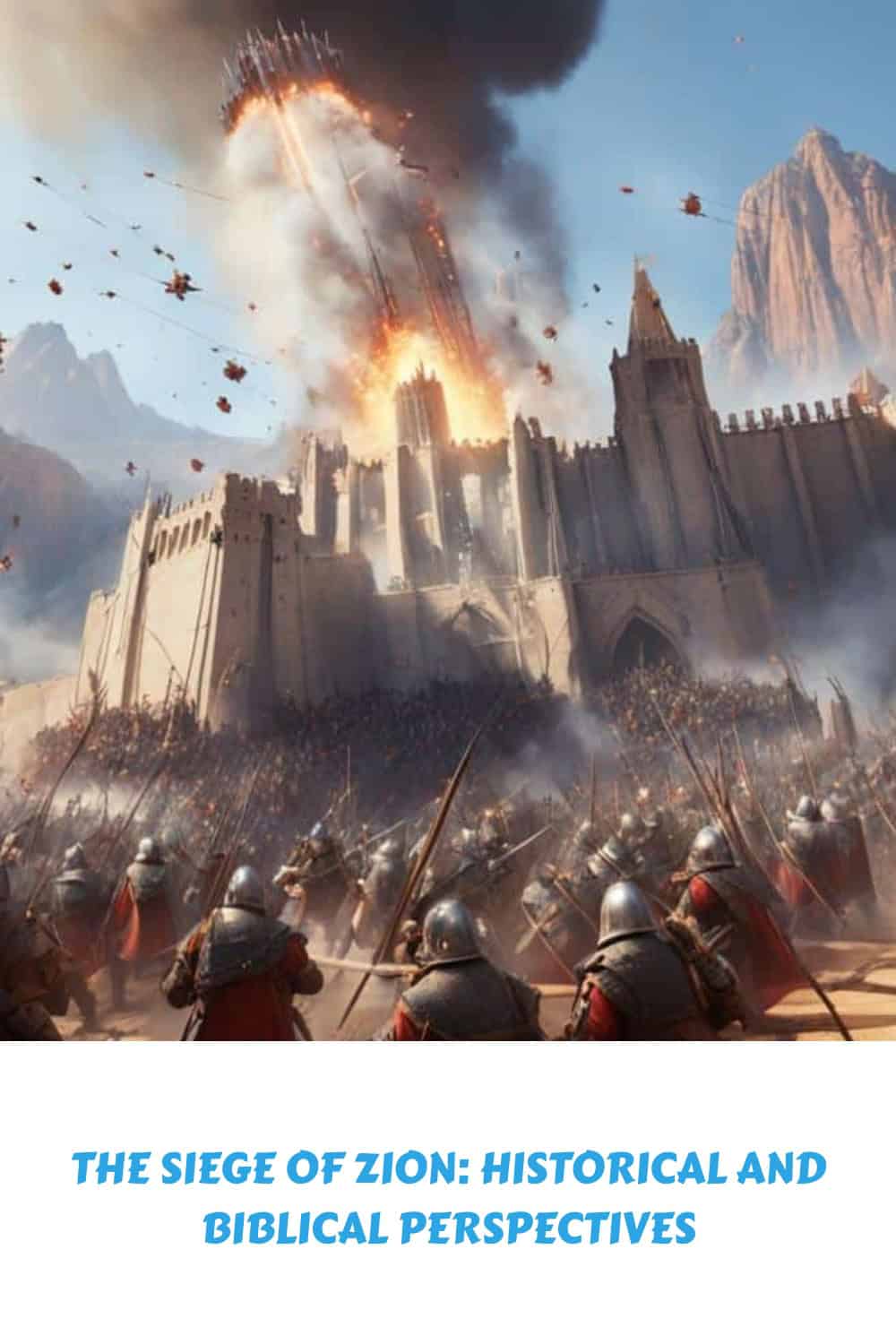Table of Contents
Have you ever wondered about the profound impact of the Siege of Zion?
How it connects historical sieges to spiritual battles and reveals the enduring triumph of Jesus in the face of adversity?
In this article, we delve into the historical and biblical perspectives of the Siege of Zion, exploring its significance and unveiling hidden truths that will leave you questioning what you thought you knew.
Join us as we embark on a journey through history and scripture, uncovering parallels and insights that shed light on the triumph of Jesus amidst the trials of Zion.
From the prophecies of Isaiah and Zechariah to the accounts in Matthew and Revelation, we uncover the symbolism and deeper meanings that intertwine the Siege of Zion with the story of Jesus.
So, are you ready to challenge your beliefs and gain a fresh perspective on the Siege of Zion?
Let’s begin our exploration of this captivating narrative that will leave you inspired and enriched.
The Siege in Historical Context: Where is Jesus in Zion’s Battles?
To truly understand the Siege of Zion, it is essential to delve into its historical context and the pivotal role of Jesus in these battles.
The historical sieges of Jerusalem not only reflect the physical struggles faced by the city but also mirror the spiritual battles that Jesus endured during His time on earth.
By exploring this historical backdrop, we can gain a deeper understanding of Jesus’ ultimate victory and its significance in our lives today.
Historical Context:
The Siege of Zion took place during a tumultuous period in Jerusalem’s history. Throughout the centuries, Jerusalem faced numerous sieges and invasions from various empires, including the Babylonians, Romans, and others.
These sieges brought destruction, devastation, and a profound sense of loss. The physical battles for Jerusalem were marked by bloodshed, hardship, and relentless struggle.
Jesus in Zion’s Battles:
Within this historical context, Jesus emerged as a central figure in the narrative of Zion’s battles. His ministry, teachings, and ultimate sacrifice are deeply intertwined with the struggles and triumphs of Jerusalem.
Just as Jerusalem endured sieges, Jesus faced his own spiritual battles, contending with opposition, rejection, and the weight of the world’s sin upon His shoulders.
But Jesus was not merely a participant in Zion’s battles; He was the ultimate victor. His death and resurrection brought a new hope and restoration to the city and to all who believe in Him. Through His sacrifice, Jesus overcame the forces of darkness and secured eternal victory for humanity.
“For God so loved the world, that he gave his only Son, that whoever believes in him should not perish but have eternal life.” – John 3:16 (KJV)
By exploring the historical context of the Siege of Zion and recognizing Jesus’ role in these battles, we gain a profound appreciation for the depth of His love and His unwavering commitment to bring hope, redemption, and victory to our lives.
Psalm 46: God as Our Refuge and Strength
As we navigate the treacherous waters of life, we often find ourselves in need of refuge and strength. In Psalm 46, we are reminded that God is our ultimate source of protection and the anchor that holds us steady.
This powerful psalm, woven with poetic imagery, unveils the unwavering presence of God amid chaos and challenges.
The opening verses of Psalm 46 declare, “God is our refuge and strength, a very present help in trouble.” These words resonate with solace and reassurance, offering comfort to those walking through times of adversity.
In a world filled with uncertainty, we find courage in knowing that God is our fortress, a safe haven where we can find shelter.
Just as Zion sought comfort and protection amid sieges, we too can turn to God as our refuge and strength.
We often face trials and tribulations that threaten to overwhelm us, but the steadfastness of God remains constant. In our moments of weakness, He becomes our strength, empowering us to face challenges with courage and resilience.
“Be still, and know that I am God,” the psalm continues. These words invite us to trust in the sovereignty and faithfulness of God, urging us to surrender our worries and fears to Him. In the midst of chaos, being still allows us to experience God’s presence in a profound and transformative way.
Throughout our lives, we have witnessed the refuge and strength of God in action. We can recall those moments when, against all odds, He provided a fortress of support and comfort.
Whether it was a sudden breakthrough in a challenging situation or an overwhelming sense of peace in the midst of chaos, these encounters serve as a testament to the reality of God’s refuge and strength.
Just as Psalm 46 reminds us, God is not a distant deity but a present help in times of distress. He is actively involved in our lives, offering solace, guidance, and protection.
In Jesus, we find the embodiment of God’s refuge and strength. His compassion, power, and unwavering love provide a lifeline in the midst of our trials.
So, as we reflect on the words of Psalm 46, let us take comfort in the truth that God is our refuge and strength. In times of trouble, we can find sanctuary in His loving arms.
Let us draw near to Him, seeking the shelter and empowerment that only He can provide.

Let us meditate on the words of this Psalm and anchor ourselves in the unchanging nature of our refuge and strength. In Him, we find peace, hope, and the unwavering assurance that we are never alone.
Isaiah 52: The Awakening of Zion
Isaiah 52 is a prophecy that resonates with the awakening of Zion, symbolizing the resurrection and triumph of Jesus Christ. This powerful passage offers profound implications for believers today as it unveils the divine plan for redemption and restoration.
In Isaiah 52:13-15, the prophet foretells the exaltation of the suffering servant, who is none other than Jesus. It speaks of how the Messiah will sprinkle many nations and cleanse them from sin, offering salvation and hope.
This awakening of Zion signifies not only the physical liberation of Jerusalem but also the spiritual awakening and renewal that Christ brings to His people.
The parallels between Isaiah’s prophecy and the resurrection of Christ are awe-inspiring. Just as Jesus emerged victorious from the grave, the awakening of Zion signifies the triumph of righteousness over sin and the establishment of God’s eternal kingdom.
As believers, this prophecy holds immense significance for our lives. It reminds us of the unshakable hope we have in Jesus, who has conquered death and offers us the gift of eternal life.
It calls us to find solace in the awakening of Zion, knowing that our faith is not in vain and that we can confidently face the challenges of life, assured of Christ’s ultimate victory.
The Triumph of Christ
Isaiah 52 serves as a powerful reminder of God’s faithfulness and His plan for redemption. It points to the ultimate triumph of Christ and His ability to bring light to the darkest of circumstances.
“Awake, awake; put on thy strength, O Zion; put on thy beautiful garments, O Jerusalem, the holy city…” – Isaiah 52:1
This resounding call to awaken encapsulates the hope and renewal that Jesus brings to the world. It serves as an invitation for us to embrace the awakening of Zion in our own lives, putting on the strength and beauty of Christ as we navigate the challenges and trials of our journey.
Indeed, Isaiah 52 reveals a glimpse of the glorious future that awaits us as believers. It paints a vivid picture of the awakening of Zion, where righteousness reigns and God’s people experience full restoration.
This prophecy encourages us to place our trust in Jesus, knowing that through Him, we will experience the ultimate awakening and be partakers in the triumph of Zion.
The Prophecy Unveiled
As we reflect on Isaiah 52, let us meditate on the awakening of Zion and its profound implications for our lives. It serves as a reminder of God’s unwavering love, grace, and power to transform even the direst of circumstances.
May this prophecy inspire us to embrace the awakening of Zion in our own lives, allowing Christ to break the chains of sin and bring forth new life. Let us put on the garments of righteousness and walk in the victory that Jesus achieved through His resurrection.
Remember, the awakening of Zion is not merely a future event; it is a present reality that we can experience in our relationship with Jesus. As we submit to His lordship, we become part of His eternal kingdom, filled with hope, joy, and the assurance of His ultimate triumph.
The Awakening of Zion
| Key Themes | Biblical References |
|---|---|
| Resurrection and Triumph | Isaiah 52:13-15 |
| Redemption and Restoration | Isaiah 52:9-10 |
| Hope and Renewal | Isaiah 52:1-2 |
| Victory over Sin | Isaiah 52:9-12 |
Zechariah 12: The Mourning of Zion and the Pierced Messiah
In the book of Zechariah, we see a profound connection between the mourning in Zion and the mourning for Jesus. This connection foreshadows the nature of Christ’s sacrifice and points to a deeper spiritual truth.
In Zechariah 12:10, it says, “And I will pour upon the house of David, and upon the inhabitants of Jerusalem, the spirit of grace and of supplications: and they shall look upon me whom they have pierced, and they shall mourn for him, as one mourneth for his only son, and shall be in bitterness for him, as one that is in bitterness for his firstborn.”
The piercing of the Messiah is a significant event that brings about deep mourning in Zion. It is a sorrowful moment that mirrors the mourning experienced when losing a beloved son. This verse is filled with prophetic implications, revealing the sacrificial nature of Jesus’ death and the emotional impact it has on those who believe.
Zechariah 12 not only reveals the mourning that will take place in Zion, but it also sheds light on Jesus as the pierced Messiah. The piercing refers to the wounds inflicted on Jesus during His crucifixion, fulfilling the prophecies foretold centuries before His birth.
As we reflect on Zechariah 12, we are reminded of the depth of Jesus’ sacrifice on the cross. His death was not only physical but also spiritual, as He carried the weight of the world’s sins upon Himself.
The piercing of His body represents the ultimate act of love and redemption, bringing salvation to all who believe.
Through Zechariah 12, we gain a deeper understanding of the significance of Jesus’ sacrifice and the connection it has to the mourning in Zion. It is a powerful reminder of the price paid for our salvation and the immense love that God has for each and every one of us.
Now, let’s take a look at the following table for a comparison between the mourning in Zion and the mourning for Jesus:
| Mourning in Zion | Mourning for Jesus |
|---|---|
| Occurs in the context of historical events | Occurs during Jesus’ crucifixion and death |
| Marked by deep sorrow and bitterness | Elicits profound grief and lamentation |
| A result of the people’s rebellion against God | A consequence of humanity’s sin and rejection of Jesus |
| Leads to a turning point and repentance | Leads to the opportunity for salvation and reconciliation with God |

As we consider the parallels between the mourning in Zion and the mourning for Jesus, we are reminded of the profound sacrifice Jesus made on our behalf. His pierced body became the ultimate symbol of redemption, bringing hope and salvation to all who believe.
In the next section, we will explore another significant moment in Jesus’ journey: His triumphal entry into Jerusalem as the King of Zion.
Matthew 21: Jesus’ Triumphal Entry as the King of Zion
As you delve into the events of Matthew 21, you witness a momentous occasion in Jesus’ ministry—the triumphal entry into Jerusalem.
This event carries profound symbolism as Jesus, the long-awaited Messiah, enters the city on a donkey, fulfilling the prophecies of the Old Testament. It is a moment of anticipation and celebration, marking Jesus’ public declaration as the King of Zion.
The spectacle of Jesus riding into Jerusalem on a donkey signifies his humility and kingship. In ancient times, a king would ride on a horse, symbolizing power and conquest.
However, Jesus, in his divine wisdom, chose a humble donkey, showcasing his role as a servant leader and contrasting the earthly perceptions of kingship.
This triumphal entry aligns with the prophecy in Zechariah 9:9, which states, “Rejoice greatly, O daughter of Zion! Shout aloud, O daughter of Jerusalem! Behold, your king is coming to you; righteous and having salvation is he, humble and mounted on a donkey, on a colt, the foal of a donkey.”
Through this act, Jesus fulfills the messianic prophecy, affirming his identity as the long-awaited King of Zion.
“Rejoice greatly, O daughter of Zion! Shout aloud, O daughter of Jerusalem! Behold, your king is coming to you; righteous and having salvation is he, humble and mounted on a donkey, on a colt, the foal of a donkey.” – Zechariah 9:9
The significance of Jesus’ triumphal entry extends beyond the historical event. It represents the kingship of Jesus in your own life. Just as the people of Jerusalem enthusiastically received Jesus as their King, you also have the opportunity to receive and acknowledge Jesus as the King of your heart.
Reflect on the implications of Jesus’ kingship in your life. Consider how surrendering to his leadership brings about transformation and restoration. Allow Jesus to reign over every aspect of your life, guiding your thoughts, decisions, and actions.

| Symbolism of Jesus’ Triumphal Entry | Implications for Believers |
|---|---|
| Humility in Kingship | Embrace servant leadership and humility in your own life. |
| Fulfillment of Prophecy | Trust in the faithfulness of God’s promises and prophecies. |
| Public Declaration of Jesus’ Kingship | Acknowledge Jesus as the King of your heart and surrender to his leadership. |
| Opportunity for Restoration and Transformation | Allow Jesus to reign over every aspect of your life, bringing about restoration and transformation. |
The triumphal entry in Matthew 21 serves as a powerful reminder of Jesus’ sovereignty and his desire to be the King of Zion in your life. Embrace his kingship, let go of worldly expectations, and experience the abundant life that comes from surrendering to Jesus, the King of Zion.
Revelation 21: The New Jerusalem as a Symbol of Christ’s Bride
As we progress through the book of Revelation, we encounter the breathtaking vision of the new Jerusalem. Described as a city coming down from heaven adorned as a bride for her husband, the new Jerusalem serves as a powerful symbol of the unification between Christ and His bride, the Church.
Revelation 21 presents a glimpse of the glorious future that awaits believers, where all pain, suffering, and tears will be wiped away. This new Jerusalem represents the fulfillment of God’s promise to dwell with His people, to be their God, and for them to be His people.
The imagery of the new Jerusalem as a bride echoes throughout Scripture, reminding us of the intimate relationship between Christ and His followers.
Just as a bride eagerly awaits her groom, the Church eagerly anticipates the glorious union with its Savior. This union signifies the eternal bond between Christ and His people, where they will reign with Him forever.
Through the symbolism of the new Jerusalem, we are reminded of the unshakeable hope we have in Christ, especially in the face of trials and tribulations, such as the Siege of Zion.
Just as the new Jerusalem represents the ultimate victory of Christ, the believing community can find solace in the knowledge that they are part of this greater story of triumph and redemption.
“And I heard a great voice out of heaven saying, Behold, the tabernacle of God is with men, and he will dwell with them, and they shall be his people, and God himself shall be with them, and be their God.” (Revelation 21:3)
The New Jerusalem and the Siege of Zion
In the context of the Siege of Zion, the symbolism of the new Jerusalem takes on a profound meaning.
As believers face the challenges and persecution of living in a fallen world, the new Jerusalem serves as a beacon of hope, reminding us that our sufferings are temporary and that a glorious eternal city awaits.
Just as the new Jerusalem represents the culmination of God’s redemptive plan, the Church, as Christ’s bride, is called to endure with unwavering faith. Our hope rests in the ultimate victory of Christ, who has conquered sin and death, and who will establish His eternal kingdom.
By focusing on the imagery of the new Jerusalem, believers can find encouragement and strength to persevere in the midst of the Siege of Zion. The trials we face today are but a small part of a greater narrative, where Christ will bring about a complete restoration and unification with His bride.
As we navigate the challenges of this world, may the vision of the new Jerusalem serve as a constant reminder of the hope, joy, and eternal glory that awaits us in Christ.
Let us lean into this promise, drawing strength from it as we face the battles and sieges of life, knowing that our ultimate victory has already been secured by our Savior.

In Summary
Revelation 21 presents us with a stunning portrayal of the new Jerusalem, symbolizing the ultimate unification of Christ and His bride, the Church. This vision serves as a powerful reminder of the hope and promise that believers can cling to in the midst of trials, such as the Siege of Zion.
As we await the fulfillment of this glorious vision, let us find strength, perseverance, and encouragement in the knowledge that our Savior has secured our ultimate victory.
The new Jerusalem represents the culmination of God’s redemptive plan and the eternal bond between Christ and His people, offering solace, hope, and a glimpse of the glorious future that awaits us.
Luke 19:41-44: Jesus Weeps Over Jerusalem
In the midst of His triumphal entry into Jerusalem, Jesus took a moment to pause and weep over the city.
Luke 19:41-44 gives us a glimpse into the deep sorrow that Jesus felt for Jerusalem and the impending destruction that awaited it. As we delve into this passage, we begin to understand the reasons behind Jesus’ tears and the connection to the historical sieges of Zion.
Jesus’ tears for Jerusalem were not merely a display of emotion; they revealed His compassionate heart and His longing for the people to recognize the divine purpose of His visitation.
The city that was meant to be a place of peace and worship had become hardened in its rejection of the Savior. Jesus wept because He knew the devastating consequences that their choice would bring upon them.
“If thou hadst known, even thou, at least in this thy day, the things which belong unto thy peace! but now they are hid from thine eyes.”
– Luke 19:42
Jesus’ deep compassion and love for Jerusalem is a reflection of His character and His heart for all of humanity. His tears signify His understanding of the pain and suffering that accompany the consequences of our choices.
Even in the face of impending destruction, Jesus yearned for the people to turn to Him, to find true peace and salvation.
This passage also highlights the parallel between Jesus’ visitation to Jerusalem and the historical sieges of Zion.
Throughout its history, Jerusalem had experienced numerous sieges, both physical and spiritual. These sieges were a result of disobedience and rebellion against God, ultimately leading to destruction and exile.
Jesus’ tears not only signify the impending destruction of Jerusalem, but also foreshadow His own impending suffering and sacrifice on the cross.
Just as Jerusalem faced the consequences of its rebellion, Jesus willingly embraced the weight of human sin and took upon Himself the punishment we deserved. His tears remind us of the immense price He paid for our redemption.
As we reflect on Luke 19:41-44, we are called to examine our own hearts and respond to Jesus’ call. Like Jerusalem, we have a choice to make – to recognize His visitation and turn to Him, or to stubbornly persist in our own ways.
Jesus’ compassion invites us to find solace and salvation in Him, even in the midst of chaos and destruction.
The Deep Compassion of Jesus
One cannot help but be moved by the depth of Jesus’ compassion as He weeps over Jerusalem. In a world full of pain and suffering, Jesus offers Himself as the ultimate source of comfort and hope.
His tears remind us that He understands our pain and is intimately acquainted with our sorrows.
As we navigate our own spiritual battles and face the consequences of our choices, Jesus’ compassion stands as a reminder of His unwavering love for us. He longs to gather us under His protective wings, just as a mother bird gathers her chicks.
“How often would I have gathered thy children together, even as a hen gathereth her chickens under her wings, and ye would not!”
– Luke 13:34
Jesus’ tears over Jerusalem are a poignant reminder that His heart breaks for the suffering and pain in our world. In the midst of our own trials, we can find solace in His compassion and seek His guidance to navigate our journey.
The Response to Human Suffering
Jesus’ response to the suffering of Jerusalem provides us with valuable insights into His character and His response to human suffering. He did not turn a blind eye or remain indifferent; instead, He wept. This exemplifies His deep empathy and His desire to alleviate human suffering.
Jesus’ tears over Jerusalem challenge us to examine our own response to the suffering we see around us.
Are we moved with compassion, or do we turn away in indifference?
His example inspires us to be agents of compassion, extending a helping hand to those in need, just as He did.
The Message of Hope
Although Jesus wept for Jerusalem, His tears also carry a message of hope. They remind us that even in the midst of destruction and pain, there is redemption and restoration. Jesus’ sacrifice on the cross paved the way for reconciliation with God and the promise of eternal life.
As we reflect on Jesus’ tears over Jerusalem, we are reminded of His longing for us to turn to Him and find solace in His saving grace. His compassion and love offer us a glimmer of hope in the midst of our own battles, reassuring us that He is with us and working all things together for our good.
Let us, then, heed the call to turn to Jesus, to find comfort in His compassion, and to embrace the hope that He offers. Just as Jesus wept over Jerusalem, He weeps with us in our pain and rejoices with us in our victories.

As we journey through the Siege of Zion, may we be reminded of Jesus’ tears and the compassion that flows from His heart. In our moments of despair and uncertainty, may His tears be a source of comfort and hope, guiding us towards a deeper understanding of His love for us.
Hebrews 12:22-24: The Heavenly Jerusalem and Jesus’ Mediation
In the book of Hebrews, we are given a glimpse into the heavenly Jerusalem and the role of Jesus as our mediator. This passage reminds us of the eternal hope we have as believers, even in the midst of spiritual battles.
The description of the heavenly Jerusalem in Hebrews 12:22-24 paints a picture of a glorious city. It is described as “Mount Zion, the city of the living God” and “the heavenly Jerusalem.”
This imagery symbolizes the ultimate destination and dwelling place of the redeemed. It represents a realm of divine perfection and eternal peace.
As believers, we face challenges and trials in our daily lives. We may feel overwhelmed by the battles we encounter, both internally and externally.
However, the heavenly Jerusalem serves as a reminder of the hope we have in Christ. It is a source of comfort and encouragement, knowing that one day we will dwell in the presence of God and experience His perfect peace.

Furthermore, Hebrews 12:24 highlights the significance of Jesus’ role as our mediator. It states, “Jesus the mediator of a new covenant.” Jesus’ mediation is essential in bridging the gap between God and humanity.
Through His sacrifice on the cross, He has provided a way for us to approach God with confidence and receive forgiveness for our sins.
Jesus’ mediation brings hope and reconciliation to those who believe in Him. It reminds us that we are not alone in our battles, but have a Savior who intercedes on our behalf.
His loving sacrifice enables us to have a personal relationship with God and experience the blessings of the heavenly Jerusalem.
As we navigate through the challenges of life, let us hold fast to the hope of the heavenly Jerusalem. Let us remember Jesus’ role as our mediator, who brings us closer to God and provides us with the strength to overcome spiritual battles.
May the heavenly Jerusalem and Jesus’ mediation inspire us to persevere in faith and trust in God’s ultimate victory.
Ezekiel 4: The Siege of Jerusalem as a Symbolic Act
The events described in the book of Ezekiel offer profound insights into the nature of suffering and sacrifice, particularly in relation to the Siege of Jerusalem.
In chapter 4, Ezekiel is instructed by God to portray the impending siege through a symbolic act, using his body as a canvas to depict the suffering and judgment that awaits Jerusalem.
As Ezekiel lies on his side and places a model of Jerusalem under siege, he becomes a living representation of the city’s imminent destruction. This symbolic act serves as a powerful visual reminder of the consequences of disobedience and the inevitable outcome of unrepentant sin.
“And lie thou upon thy left side, and lay the iniquity of the house of Israel upon it…” (Ezekiel 4:4)
By enduring the physical discomfort and public humiliation associated with this act, Ezekiel provides a tangible example of the suffering endured by both the righteous and the unrighteous during times of siege. This parallels the agony and humiliation that Jesus would later experience on the cross.
Just as Ezekiel’s suffering carried a prophetic message, so too did Jesus’ sacrificial death bear profound spiritual significance. Through His death and resurrection, Jesus conquered sin and death, offering salvation and forgiveness to all who believe in Him.
When examining Ezekiel’s symbolic act in light of Christ’s sufferings, we can uncover various parallels. Both convey the consequences of rebellion against God and the necessity of repentance. Additionally, they highlight the pain and anguish that both the innocent and guilty endure as a result of sin.
Furthermore, Ezekiel’s portrayal of the siege emphasizes the importance of recognizing the gravity of one’s actions and seeking reconciliation with God. The destruction of Jerusalem was a physical manifestation of the consequences of disobedience, just as the crucifixion of Jesus demonstrated the gravity of sin and the need for redemption.
As we reflect on Ezekiel’s symbolic act, we are reminded of the immense love and grace that Christ displayed on the cross. The suffering endured by both Ezekiel and Jesus serves as a testament to the power of sacrifice and the redemptive nature of God’s plan for humanity.
Through Ezekiel 4, we gain insights into the symbolic significance of the Siege of Jerusalem and its connection to Christ’s ultimate sacrifice. It serves as a reminder of the need for repentance, the consequences of disobedience, and the hope that can be found in the redemptive work of Jesus.

How Did the Siege of Zion Impact Jerusalem’s History and Biblical Perspectives?
The conflicts and conquests in Jerusalem’s history have left a lasting impact on the city, and the siege of Zion was no exception. This event reshaped Jerusalem’s history and holds significant importance in biblical perspectives, influencing the city’s religious and cultural development for centuries to come.
John 2:19-21: Jesus Predicts the Temple’s Destruction
Jesus’ prophecy about the temple’s destruction holds profound significance in the context of the Siege of Zion. In John 2:19-21, Jesus predicts the temple’s demise, foreshadowing the ultimate triumph that awaits Him and His followers.
As we reflect on this passage, we are reminded of the broader theme of siege and restoration. Just as the physical temple would face destruction, so too would Jerusalem experience a period of extreme tribulation.
Yet, amidst the challenges, Jesus’ prediction points to the victory that awaits—a victory that transcends the temporal and ushers in eternal significance. It serves as a reminder that even in the most trying times, Jesus’ power and promise remain unshakable.
For our understanding of the Siege of Zion, John 2:19-21 offers a glimpse into the greater narrative of spiritual warfare and redemption. It prompts us to reflect on the profound implications of Jesus’ words and the hope they inspire in our hearts.






